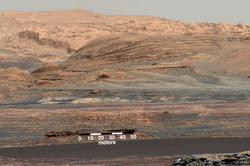 Geophysics explained the mechanism of the loss of Mars a dense atmosphere. The results of their own research, the authors published in the journal Nature Communications, and briefly about them tells on the website of NASA. Geophysics explained the mechanism of the loss of Mars a dense atmosphere. The results of their own research, the authors published in the journal Nature Communications, and briefly about them tells on the website of NASA.
Given the view of scientists, 3.8 billion years ago on Mars was quite wet and warm climate to maintain the existence of reservoirs. This was facilitated, for example, the dense atmosphere of the planet.
It is currently the atmosphere of Mars is 95 percent carbon dioxide (carbon dioxide). Taking into account the opinion of academics, in the distant past in an air shell of the planet among others dominated this gas.
Carbon from the atmosphere, as did the researchers, could have gone 2 ways. 1st is the possibility of its absorption of the Martian crust. Method 2 connects the carbon loss with his departure into space.
Studies with the Mars orbiting satellites and Rovers were denied a first guess, as in the upper layers of the crust of the planet these devices showed no evidence of excess lung content of carbon. If you look from another angle, the study of the relationship of the content of the isotopes carbon-12 and carbon-13 have demonstrated abnormally high number of heavy carbon in the planet's atmosphere.
Researchers presented that the light isotopes could get into space. It's approved and researchers in their own new job. According to them, a very long time on Mars had similar terrestrial carbon cycle. Initially, this compound is in the form of carbon dioxide remained in the mantle and the eruption of volcanoes into the atmosphere. On the surface of Mars in the vicinity of the polar caps, he could be in the ice and go into a gas with the change of seasons.
Besides carbon dioxide could dissolve in the water, which then fell as rain and fall on land or the waters of Mars. At the same time, over time, a significant number of lung carbon went into space. It happened, as scientists think, due to photodissociation (chemical reaction leading to the disintegration under the action of electromagnetic radiation connections on components) carbon dioxide.
When irradiated by UV in the upper atmosphere carbon dioxide was split into carbon monoxide and oxygen, after that 1st connection under the action of radiation again was split into carbon and oxygen.
Some of the carbon atoms have sufficient energy to leave the atmosphere of Mars and to be in space. Taking into account the opinion of researchers, this device is sufficient for the loss of atmosphere of Mars is carbon that is 3.8 billion years ago was a little less dense than earth.
Previously, American geophysicists have found that every second the atmosphere of Mars is losing about 100 g of matter. To their own conclusions scientists came after data analysis from an orbiting satellite MAVEN (Mars Atmosphere and Volatile Evolution).
sections: Society, World News
|